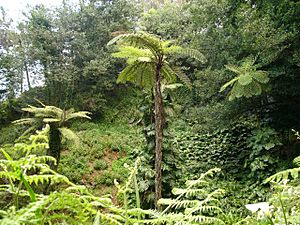Lacy tree fern facts for kids
Quick facts for kids Lacy tree fern |
|
|---|---|
 |
|
| In Blandys Garden, Madeira | |
| Scientific classification | |
| Synonyms | |
|
The Sphaeropteris cooperi, also known as the lacy tree fern or Cooper's tree fern, is a type of tree fern. It is originally from Australia, specifically the areas of New South Wales and Queensland.
What is a Lacy Tree Fern?
The lacy tree fern is a medium to large plant. It grows very quickly. It can reach heights of up to 15 meters (about 50 feet). Its trunk can be about 30 centimeters (12 inches) thick.
The top part of the trunk and the new, unfurling leaves (called crosiers) are very pretty. They are covered with long, silky, straw-colored scales. The fern's crown, which is the top part with all the leaves, spreads out widely. Its light green fronds (leaves) can grow to be 4 to 6 meters (13 to 20 feet) long.
Growing Lacy Tree Ferns
The lacy tree fern is one of the most popular tree ferns to grow. People use it in gardens and for public landscaping. It is a tough plant and quite easy to take care of.
If there are very cold frosts, the fronds might get damaged. However, the plant usually recovers quickly. This fern likes places that are protected, shady, and moist. It can also grow in sunny spots, but it needs a lot of water there. It looks its best when it's not in full sun.
The Royal Horticultural Society gave this fern an "Award of Garden Merit." This award means it is a great plant for gardens. Sometimes, in plant nurseries, it is wrongly called "Cyathea australis."
Where Lacy Tree Ferns Live
This tree fern is native to parts of Australia. However, it has started growing naturally in other places too. These include Western Australia, South Australia, and some areas of New South Wales where it wasn't originally found.
It has also spread to Hawaii. In Hawaii, it has become a problem. It is an invasive species, which means it grows very fast and can take over areas, harming the native plants.
Gallery











